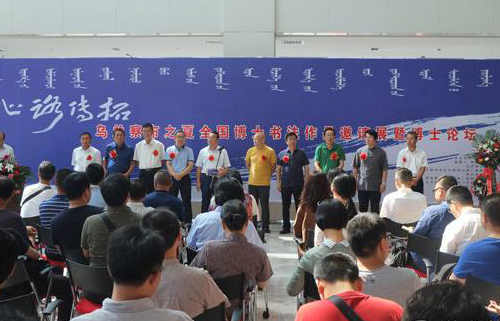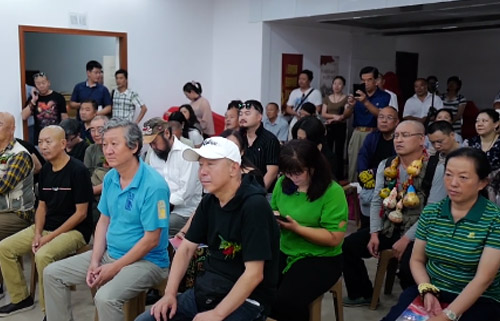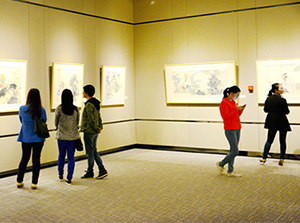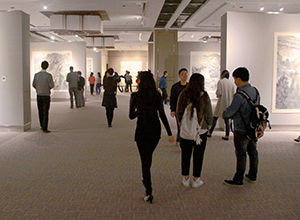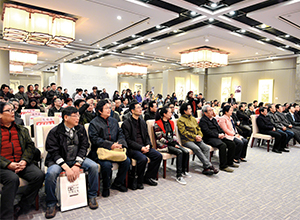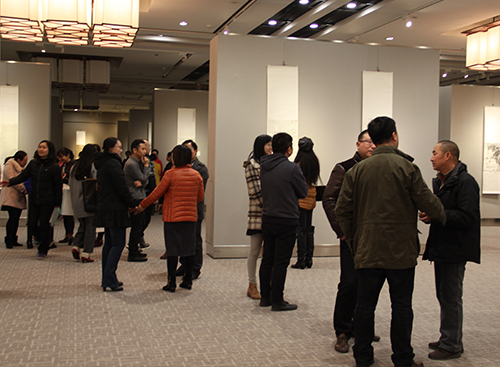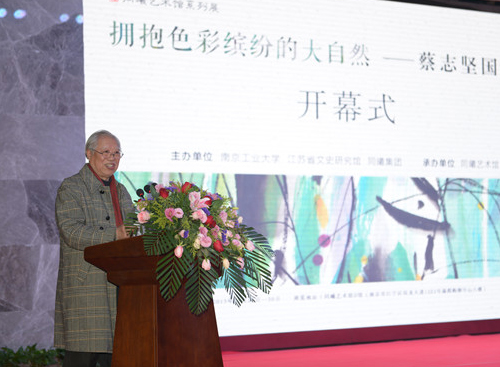1000+项目“韩梦云:玉屑集”启幕
时间:2019-04-24 来源: 雅昌艺术网 作者: 雅昌艺术网
1000+项目“韩梦云:玉屑集”
展览日期:2019/04/26 — 2019/06/09
开幕酒会:2019/04/26 15:00-18:00(星期五)
艺术家:韩梦云
出品:千高原艺术空间
作品媒介:绘画、装置
展览地点:四川省成都市高新区盛邦街,铁像寺水街南广场,千高原艺术空间
艺术家韩梦云经年积习于梵语、佛教与佛教艺术,这让她得以广涉细究大量的佛寺遗址出土报告。我们从这类考古报告中读到的大多是陶器的碎片、织物的残缕、无首的佛、断臂的菩萨或无形之物。虽然都难逃时间的暴政,但它们的美仍然在缺失残破之中闪烁着灵光。这些时间的残余也恰好应证了佛教对无常的理解:
譬如陶家,埏埴作器,
一切要壞,人命亦然。
《北傳法句經・第一無常品》
这次画展的题目来自魏庆之的《诗人玉屑》,这一意象的挪用是用来强调韩梦云对残破的理念、物件、认同与历史的理解。
这次展览是对韩梦云最近佛教题材墨画的一次陈布,是她对从印度、健陀罗、尼泊尔到中国乃至其余东亚各地佛教雕塑的研究的结果。在游历敦煌莫高窟与其它佛教艺术遗址时,韩梦云意识到佛像与佛龛、以及与整个石窟群的星罗密布的空间关系,与当代装置艺术之间的相似性,亦即这两者都是建构于空间与身处其中的观者的身体体验之间的艺术。韩梦云尝试重新塑造古代石窟,她拆分并重新陈设了固有元素中的空间架构、文本与图像。
韩梦云, 玉屑集 1, 纸上水墨, 38.5x26.5cm, 2018
Hang Mengyun, Splinters of Jade 1, Ink on paper, 38.5x26.5cm, 2018
这次展览中也包括了由艺术家本人与泰国玛希敦大学佛教学教授玛提亚·沙维尼一同摘取的佛经、佛论与佛教诗歌。沙维尼教授认为图像与文本的协作常常是对菩萨面相的直接印象,以唤起有关慈悲的特定偈颂,而有时与图像的匹配则强调的是佛教二谛的矛盾与本质上的和谐,这一点在佛教的文献中一般表述为:最上的佛教三宝并不落于知觉或心智的统摄范围之内——因此,我们会寻求将容纳这一智慧的文字分列在佛与菩萨的视觉现身之旁。
韩梦云, 玉屑集 2, 纸上水墨, 38.5x26.5cm, 2018
Hang Mengyun, Splinters of Jade 2, Ink on paper, 38.5x26.5cm, 2018
为了暗示“观”的不同方式,展览的空间经过了周密设计,而空间之中的文本与图像则将会展示佛教诸观的深度与广度,不仅是从艺术地,而且是哲学地与经验地。
1000+ Han Mengyun: Splinters of Jade
Duration: 26/04/2019 –09/06/2019
Opening: 26/04/2019, 15:00-18:00, Friday
Organizer: A Thousand Plateaus Art Space
artists: Han Mengyun
Media: Painting, Installation
Venue: A Thousand Plateaus Art Space, South Square, Tiexiang Temple Riverfront, Shengbang Street, High-tech Development Zone, Chengdu, China
Han Mengyun’s studies of Sanskrit and Buddhism as well as Buddhist art led her to reading archaeological reports of excavations on Buddhist sites in abundance, especially those of the British archaeologist Aurel Stein. What we generally encounter in these reports are pieces of broken pots, strips of floral textiles, headless Buddhas, armless Bodhisattvas, or the bodiless beings. Their beauty, however defaced by the atrocity of time, retains the aura even in their own fragmentation. The remnants of time attest to the Buddhist idea of impermanence:
Just like a clay vessel
Made by a potter
Each life of a mortal
Ends in breaking.
(Impermanence. Book I, Udānavarga).
韩梦云, 玉屑集 3, 纸上水墨, 32.5x46cm, 2017
Hang Mengyun, Splinters of Jade 3, Ink on paper, 32.5x46cm, 2017
The title comes from Shiren Yuxie 诗人玉屑(Jade Splinters of the Poets [on the valuable gleanings about poetry] by Wei Qingzhi 魏庆之(1240-1244) , serving as an emphasis of Han’s appreciation of fragmented ideas, artifacts, identities and histories.
Included in the exhibition are sūtras, treatises, and poems chosen by both the artist herself and Professor Mattia Salvini of Buddhist Studies at Mahidol University. According to Professor Salvini, the association between image and text is at times a direct impression of the face of a Bodhisattva that recalls certain verses on compassion, whereas in other instances, the match with an image highlights the paradox and natural harmony of the two truths, as expressed in the text: the ultimate Three Jewels are not within the range of perception or mind – thus, here we are, placing this wisdom, in words, next to visual manifestations of Buddhas and Bodhisattvas.
The text and images placed within a meticulously designed space suggesting various routes of viewing will present the depth and vastness of the Buddhist view both artistically, philosophically and experientially.
韩梦云Han Mengyun
韩梦云,1989年出生于武汉, 现工作于成都和伦敦。2012年毕业于美国Bard College, 获Studio Art学士学位。早期创作专注在用抽象绘画的语言和手法对东方审美和情绪进行再现。2015年始在京都大学古典印度学系学习梵文。2018年毕业于牛津大学Ruskin School of Art,获MFA硕士学位,期间翻译并研究了印度古典绘画理论著作《画经》(Citrasūtra)与相关梵语文献。《毗湿奴法上往世书》中所阐述的各艺术门类之间的独立而互通的关系让她重新审视诗歌和绘画、语言和图像之间的融合与分离之处。
在过去6年学习梵文和佛教并同时研习临摹西域佛教壁画和佛教造像的过程中,韩梦云深刻地体悟到错综复杂的文化交流以及文明作为混杂体的本质,这是她从抽象回归具象,并试图消解自性,消弭抽象和具象、东方与西方的二元对立,在古典思想中回溯艺术的发端。
Han Mengyun (b.1989, Wuhan, China), currently lives and works in Chengdu and London. Graduated from Bard College with a degree in Studio Art in 2012, Han explored painterly representations of eastern aesthetics and sensibilities with the abstract expressionist language that marks the artistic influence that she underwent in the US. Her quest for a deeper understanding of eastern philosophies prompted her to study Sanskrit at Kyoto University in Japan in 2015 and she continued her research and artistic practice at the MFA program at Ruskin School of Art, University of Oxford in 2018. Her academic research undertaken at Oxford focuses on the interrelationship and interdependence of the arts addressed in Citrasūtra, the ancient Indian treatise on painting in Viṣṇudharmottara Purāṇa,which allows her to further investigateinto the territories where poetry and painting, language and image, merge and diverge.
During her studies of Sanskrit and Buddhism, as well as Buddhist mural paintings and sculptures, Han’s practice has witnessed a drastic change from abstraction back to representation, from the dichotomy between the East and the West to seeing the world in global connections and communications, in which styles and motifs in transit attest to the nature of hybridity in all forms of art and the task of an artist is that of a translator.
*特别鸣谢:感谢一门社设计制作工作室(Amass Studio)为这次展览提供的技术支持、佛龛的设计和制作
